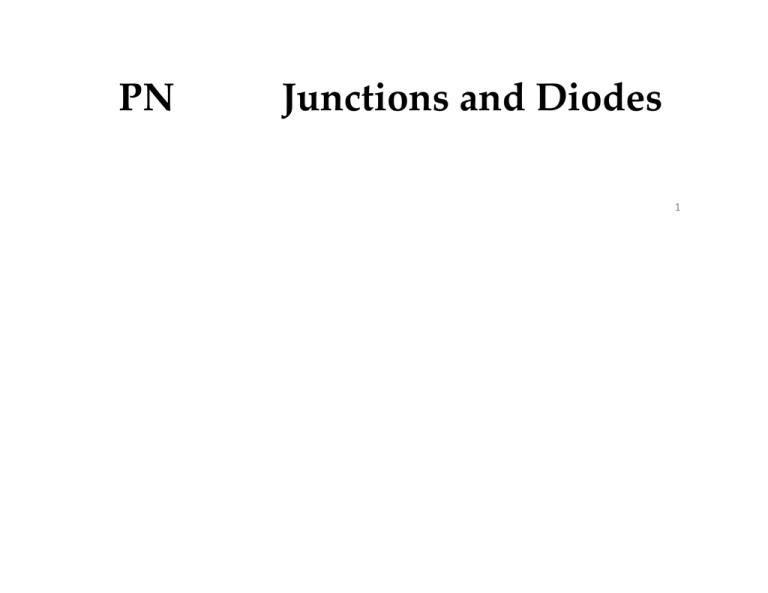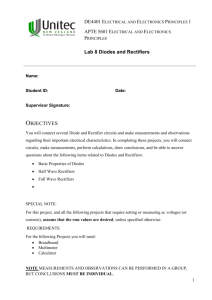PN Junctions and Diodes
advertisement

PN Junctions and Diodes 1 Definitions FYI B: material dependent parameter = 5.4 × 1031 for Si EG: Bandgap energy = 1.12 eV k: Boltzmann constant=8.62×10-5 ev/K ni: intrinsic carrier concentration At T = 300 K, ni = 1.5 × 1010 carriers/cm3 Jp: current density A/m2 q: electron charge Dp: Diffusion constant (diffusivity) of holes μp: mobility for holes = 480 cm2 /V sec μn: mobility for electrons = 1350 cm2 /V sec ND: concentration of donor atoms nno: concentration of free electrons at thermal equilibrium NA: concentration of acceptor atoms ppo: concentration of holes at thermal equilibrium D D kT Einstein Relation : n = p = = VT : thermal voltage q μn μ p PN Junction • When a p material is connected to an n-type material, a junction is formed – Holes from p-type diffuse to n-type region – Electrons from n-type diffuse to p-type region – Through these diffusion processes, recombination takes place – Some holes disappear from p-type – Some electrons disappear from n-type A depletion region consisting of bound charges is thus formed Charges on both sides cause electric field Î potential = Vo PN Junction • • Potential acts as barrier that must be overcome for holes to diffuse into the n-region and electrons to diffuse into the p-region Open circuit: No external current Junction built-in voltage From principle of detailed balance and equilibrium we get: ⎛ N AND ⎞ Vo = VT ln ⎜ ⎟ 2 ⎝ ni ⎠ For Si, Vo is typically 0.6V to 0.8V ε s : silicon permittivity ε s = 11.7ε o = 1.04 × 10−8 F/m xn N A = xp ND Charge equality in depletion region gives: qx p AN A = qxn AN D A: cross-section of junction xp: width in p side xn : width in n side Wdep = xn + x p = 2ε s ⎛ 1 1 ⎞ + ⎜ ⎟Vo q ⎝ N A ND ⎠ PN Junction under Reverse Bias • When a reverse bias is applied – Transient occurs during which depletion capacitance is charged to new bias voltage – Increase of space charge region – Diffusion current decreases – Drift current remains constant – Barrier potential is increased – A steady state is reached – After transient: steady-state reverse current = IS-ID (ID is very small) Î reverse current ~ IS ~10-15 A Under reverse bias the current in the diode is negligible The Diode + I V • Diode Properties – Two-terminal device that conducts current freely in one direction but blocks current flow in the opposite direction. – The two electrodes are the anode which must be connected to a positive voltage with respect to the other terminal, the cathode in order for current to flow. The ideal diode: (a) diode circuit symbol; (b) i–v characteristic; (c) equivalent circuit in the reverse direction; (d) equivalent circuit in the forward direction. Copyright © 2004 by Oxford University Press, Inc. ideal diodes: two modes of operation external circuit used to limit forward current (a) and the reverse voltage (b). Copyright © 2004 by Oxford University Press, Inc. Ideal Diode Characteristics + I + V V - - V<0 OFF I>0 ON I Ideal Diode Characteristics Diode Characteristics • Three distinct regions – The forward-bias region, determined by v > 0 – The reverse-bias region, determined by v < 0 – The breakdown region, determined by v < -VZK Diode Models Exponential Piecewise Linear 16 Constant-Voltage-Drop Diodes Logic Gates OR Function Y = A+ B +C AND Function Y = A⋅ B ⋅C Diode Circuit Example 1 IDEAL Diodes Assume both diodes are on; then VB = 0 and V = 0 I D2 = 10 − 0 = 1 mA 10 At node B 0 − (−10) I +1 = ⇒ I = 1 mA, V = 0 V 5 D1 is conducting as originally assumed Diode Circuit Example 2 IDEAL Diodes Assume both diodes are on; then VB = 0 and V = 0 10 − 0 I D2 = = 2 mA 5 At node B I +2= 0 − (−10) ⇒ I = −1 mA ⇒ wrong 10 original assumption is not correct … assume D1 is off and D2 is on ID2 = 10 − (−10) = 1.33 mA 15 VB = −10 + 10 × 1.33 = +3.3 V D1 is reverse biased as assumed Excercise Find I&V Figure E3.4 Copyright © 2004 by Oxford University Press, Inc. Vo = ? I = ? Figure E3.12 P3.2 V , I ?? P3.3 V= I= V= I= Analyze Circuit with load RL V0, 3 current branches Figure 3.19 Circuit for Example 3.7. Application: Diodes as Voltage Regulators • Objective – – – – Provide constant dc voltage between output terminals Load current changes Dc power supply changes Take advantage of diode I-V exponential behavior Big change in current correlates to small change in voltage Application: Diode as Rectifier While applied source alternates in polarity and has zero average value, output voltage is unidirectional and has a finite average value or a dc component (a) Rectifier circuit. (b) Input waveform Application: Rectifier (c) Equivalent circuit when vI ≥ 0. (d) Equivalent circuit when vI ! 0. (e) Output waveform. Copyright © 2004 by Oxford University Press, Inc. Figure 3.25 (a) Half-wave rectifier. (b) Equivalent circuit: diode replaced with battery-plus-resistance. (c) Transfer characteristic (d) Input and output waveforms assuming that rD ! R. Copyright © 2004 by Oxford University Press, Inc. Figure 3.4 Circuit and waveforms for Example 3.1. I=? Copyright © 2004 by Oxford University Press, Inc. Full wave rectifier Inverts –ve half of sinusoid Center tapped transformer 2 equal voltages across 2 halves +ve cycle: Vs +ve, D1 conducts thru R, D2 reverse biased -ve cycle: Vs –ve, D1 off, D2 conducts Figure 3.26 Full-wave rectifier utilizing a transformer with a center-tapped secondary winding: (a) circuit; (b) transfer characteristic assuming a constant-voltage-drop model for the diodes; (c) input and output waveforms. Copyright © 2004 by Oxford University Press, Inc. Bridge rectifier: (a) circuit; (b) input and output waveforms. +ve half cycle Vs +ve, current conducted thru D1, R, D2 (D3, D4 reverse biased -ve half cycle Vs –ve current conducted thru D3, R, D4 (D1, D2 reverse biased Copyright © 2004 by Oxford University Press, Inc. Peak Rectifier Using filter Capacitor Figure 3.28 (a) A simple circuit used to illustrate the effect of a filter capacitor. (b) Input and output waveforms assuming an ideal diode. Note that the circuit provides a dc voltage equal to the peak of the input sine wave. The circuit is therefore known as a peak rectifier or a peak detector. Copyright © 2004 by Oxford University Press, Inc. Figure 3.29 Voltage and current waveforms in the peak rectifier circuit with CR @ T. The diode is assumed ideal. Microelectronic Circuits - Fifth Edition Sedra/Smith Copyright © 2004 by Oxford University Press, Inc. Figure 3.30 Waveforms in the full-wave peak rectifier. Microelectronic Circuits - Fifth Edition Sedra/Smith Copyright © 2004 by Oxford University Press, Inc. Table 3.1 Modeling the Diode Forward Characteristic Copyright © 2004 by Oxford University Press, Inc. Figure 3.24 Block diagram of a dc power supply. Copyright © 2004 by Oxford University Press, Inc. Diode Characteristics • Three distinct regions – The forward-bias region, determined by v > 0 – The reverse-bias region, determined by v < 0 – The breakdown region, determined by v < -VZK Zener Diode, Model, I-V Figure 3.20, 21 The diode i–v characteristic with the breakdown region shown in some detail. Copyright © 2004 by Oxford University Press, Inc.



